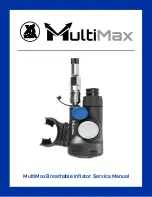
First encounters
•
The
CONTROL
connector is a 26-way military-
specification bayonet plug intended for
connecting to an external controller or Hand-
held Control Unit. It has the same pin out as
the
RECORDER
connector.
•
The
POWER
connector is a 10-way military-
specification bayonet plug, which should be
connected to a source of 12 – 30 V DC power,
for supplying to the borehole instrumentation.
When operating the hole lock, you should
connect the Hole-lock Control Unit to this
connector. Because of the potentially high
voltages and currents used, the hole lock
circuitry is entirely isolated from the rest of
the electrical systems in the sensor and
surface unit; it is not usual to power the
sensor whilst using the hole lock.
For deep-borehole installations (over 50 metres) may be necessary to use a modified
instrument (with “active-high” logic ) and a breakout box with internal line drivers,
to ensure that logic signals are reliably transmitted to the sensor. Contact Güralp
Systems for advice.
Note:
The breakout box looks very similar to other Güralp breakout
boxes. However, its internal wiring is different from that used for
some other instruments. For this reason, if you are using several
instrument types, you should mark each breakout box clearly so that
it is always used with the correct instrument.
3.3.1.1 Calibration
To calibrate the instrument, the
Calibration enable
line must be activated. This
operates a relay which allows a calibration signal to flow through the transducer
feedback coil. This provides an extra force acting on the sensor masses, producing a
corresponding deflection in the output signal, which can be analysed by a control
computer to extract the seismometer's response characteristics.
Most Güralp instruments are manufactured with “active-low”
Calibration enable
lines, which are normally left floating but are grounded to initiate calibration.
Instruments with active-high calibration can be manufactured on request.
3.3.1.2 Mass locking and unlocking
The 3TB is delivered with its sensor masses locked, so that they will not be damaged
in transit. You should lock the masses whenever you need to move the instrument.
To unlock the instrument, hold down the
ENABLE
and
UNLOCK
buttons (or the
UNLOCK
switch on a breakout box) for at least six seconds. The sensor's
13
Issue G - November 2019














































